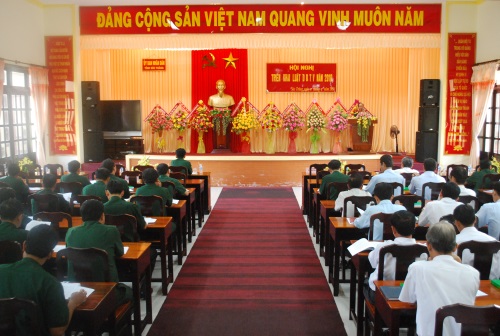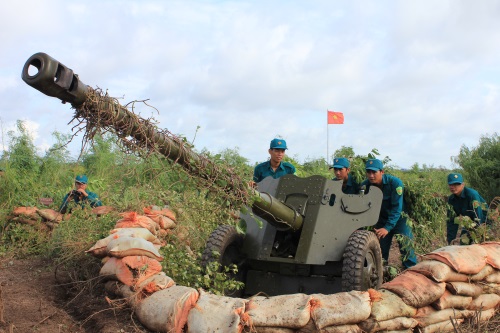Militia and Self-Defence Force plays an important role in protecting local party committees, authorities and people, and building all-people national defence at grass-roots level. Perceiving that, over the past years, the Military Party Committee and Command of Soc Trang province have actively counselled party committees and authorities at levels to strengthen leadership and direction over the implementation of the Law on Militia and Self-Defence Force (the Law for short) via guidelines and measures, meeting the requirements of the military and defence tasks at grass-roots levels, contributing to protecting political security and social order, successfully performing the task of search and rescue in the area, while stressing that it is the responsibility of party committees, authorities, leaders of agencies and organizations as well as the whole political system and people.
 |
| The conference on executing the Militia and Self-Defence Force Law held by Soc Trang province |
To begin with, the Provincial Military Party Committee and Command have led and directed military agencies at levels to counsel local party committees and governments to promote the role of agencies, committees, sectors, organizations and people, and the aggregate strength in translating the Law into practice. Great importance has been attached to including the building and operations of militia and self-defence force in programs and action plans for collaboration with committees, sectors, political and social organizations on a yearly and periodic basis. Political Division of the Provincial Military Command (hereafter PMC) and Propaganda and Education Committees of districts and cities have determined that the building and operations of militia and self-defence force act as an element of the program for work coordination. To implement the Law effectively, the PMC has directed introduction and study of the Law and the Communist Party of Vietnam Secretariat’s Decision 41/KL-TW on continued implementation of the Directive 16-CT/TW on “Strengthening the Party’s leadership over the militia and self-defence force in the new situation” as a focus, thereby raising awareness of cadres, party members, and people towards the strategic role of the militia and self-defence force in the cause of national construction and protection. That has helped raise role and a sense of responsibility in leading and directing the implementation of the Law as well as the efficiency of state management in defence and security fields. The PMC promulgated 12 documents and counselled the Provincial People’s Committee to issue 23 legal documents to direct and guide localities’ implementation of the Law. At the same time, it counselled the Provincial People’s Committee to organize training course on execution of the Law in tandem with that of Resolution of Party Congresses at levels for key cadres at levels, while stepping up the work of defence and security propagation and education to raise awareness and responsibility, and achieve unity among party committees, authorities, cadres and people towards this important task. Under the Province’s direction, localities launched training courses on the Law for cadres in charge of militia and self-defence force work from provincial level to commune level while conducting propagation through mass media to render the people and the militia and self-defence force conversant with their obligations, benefits and responsibility for building and promoting the role of this force in performing defence and military tasks.
Moreover, the Provincial Military Party Committee and Command have directed military agencies at levels to consolidate and complete the structure of the militia and self-defence force, particularly at commune level and in enterprises, in accordance with the building of militia and self-defence cadres at grass-roots levels, while combining the building of militia and self-defence force with that of strong grass-roots political bases and defensive zones. Consequently, the implementation of the Law and the building of militia and self-defence force in the area have satisfied the requirements and obtained practical results. Political quality and credibility of this force have increasingly improved. Executing the Prime Minister’s Decision 779/QĐ-TTg on “Ratifying the Project to train cadres of the commune-level military command at bachelor’s level until 2020 and beyond”, the Provincial Military Party Committee and Command have counselled the Provincial Party Committee and People’s Committee to launch 3 local military training courses for 279 cadres, and dispatch 174 cadres to study at colleges and universities for local military degree. After graduating from colleges and universities, most of the cadres posses political willpower and high level of professional competence, applying their knowledge to the localities’ conditions and giving advice to local party committees and governments in accordance with the local military and defence tasks, thereby gaining good results and being highly appreciated by local party committees and authorities. Attention has been paid to maintaining regulations on training, and improving knowledge for commune-level military command and militia and self-defence cadres at levels. Training courses have focused on updating new points of the Party’s military, defence, Homeland protection guideline, hostile forces’ plots and acts of sabotage in the area as well as localities’ military and defence tasks. The work of cadre appointment after training has been carried out in a correct, democratic, public manner, hence achieving a sense of unity among cadres and promoting the abilities of each position. Up to now, the province has appointed 108 out of 109 commune-level military command commanders, 218 out of 218 commune-level military command deputy commanders, 107 mobile militia platoon commanders, and several other cadres for positions of commune-level political system.
 |
| Militia and Self-Defence Force of Soc Trang province |
Comprehending basic points of the Law, the Provincial Party Committee and Command have directed military agencies at levels to successfully conduct the work of review, registration and management of citizens at militia and self-defence service age, laying foundation for building strong, extensive militia and self-defence force with proper structure and increasingly high synergy. Consequently, localities have seriously carried out the work of appointing and dismissing militia and self-defence cadres, admitting new militia and self-defence members and excluding cadres and soldiers discharging their obligations, while stringently maintaining the regulations on first-time, supplementary, displacing, long-term leave registration. Priority has been given to cadres and employees from production, business, service, and public service units, and graduates from universities, colleges, vocational schools experiencing military training courses to complement human resources of the militia and self-defence force in the area. The work of force selection has been conducted closely on a democratic, public and equal basis. Localities have concentrated on political check-up, launched voluntary movements, and persuaded families having members selected to join the force. As a result, the province’s militia and self-defence force has witness developments in quantity, structure and quality, accounting for 1.46% of the province’s population; having 21.10% of its members who are party members and 70.54% who are youth union members. 100% of its military party cells have party executive committee. Besides, the Provincial Military Party Committee and Command have directed military agencies at levels to focus on the work of training the militia and self-defence force as a centrepiece to enhance total quality and combat-readiness capability of this force. Yearly, military agencies at levels build up plans for training 100% of militia and self-defence units with comprehensive, focalized training contents in accordance with the structure, equipment and task of each force, the areas and local budget. During training process, localities always adhere to the guideline “basic, practical, qualitative”, closely combining combat training with education of politics, law and tradition. Due attention has been paid to training cadres and troops to grasp skills and tactics of the militia and self-defence force as well as on-site combat projects, and to improve coordination with the Public Security Force in patrol, control and settlement of situations in the area. Moreover, the militia and self-defence force has been trained in natural disaster prevention and control and mass mobilization work. Military agencies at levels have organized 129 training courses for 18,000 cadres and 500 training courses for 106,000 militia and self-defence members.
Great significance has been attached to leadership and direction over the implementation of policy work for the militia and self-defence force. Grounded in the Law and the Project on organization, training, operation and policy concerning the militia and self-defence force, military agencies at levels have worked with functional sectors to make budget forecast, receive, manage and effectively use the allocated budget, sufficiently provide responsibility allowances for militia and self-defence cadres as regulated, and guaranteeing entitlements and policies for the sick and people suffering accidents during militia and self-defence training course and service as regulated by the Law. Annually, authorities at levels deduct more money from their budget for the operations of the militia and self-defence force, while actively persuading the people and socioeconomic organizations to help the militia and self-defence members and families having members of the force with capital, materials and techniques especially during harvest or on contract, thereby alleviating difficulties of those families and facilitating militia and self-defence members’ successful fulfilment of assigned tasks.
Results and lessons from the implementation of the Law serve as an important basis for Soc Trang Provincial Military Party Committee and Command to counsel local party committees and authorities at levels to continue building strong, extensive militia and self-defence force, contributing to more successfully performing the military and defence tasks and building strong all-people national defence in the area.
Senior Colonel Tran Van Lau, Commissar of Soc Trang Provincial Military Command